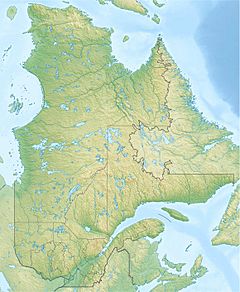Vincelotte River facts for kids
Quick facts for kids Vincellotte River |
|
|---|---|
| Native name | Rivière Vincelotte |
| Country | Canada |
| Province | Quebec |
| Region | Chaudière-Appalaches |
| MRC | L'Islet Regional County Municipality, Montmagny Regional County Municipality |
| Physical characteristics | |
| Main source | Agricultural stream Saint-Eugène 31 metres (102 ft) 47°04′35″N 70°24′00″W / 47.076279°N 70.400011°W |
| River mouth | St. Lawrence River Cap-Saint-Ignace 4 metres (13 ft) 47°03′38″N 70°27′21″W / 47.06055°N 70.45583°W |
| Length | 5.1 kilometres (3.2 mi) |
| Basin features | |
| Tributaries |
|
The Vincelotte River, known as rivière Vincelotte in French, is a small river in Quebec, Canada. It flows into the mighty St. Lawrence River near the village of Cap-Saint-Ignace.
This river runs through two different areas: Saint-Eugène and Cap-Saint-Ignace. Both of these towns are part of the Chaudière-Appalaches region in Quebec.
River's Journey
The Vincelotte River begins where two smaller streams, the Bélanger and Caouette, meet. This starting point is in a farming area in Saint-Eugène. It's located northwest of the Canadian National train tracks.
From its start, the Vincelotte River flows for about 5.1 kilometres (3.2 mi) (about 3.2 miles). Here's how its journey is divided:
- It flows for 1.8 kilometres (1.1 mi) (about 1.1 miles) towards the southwest in Saint-Eugène.
- Then, it continues for 8.8 kilometres (5.5 mi) (about 5.5 miles) towards the southwest through more farmland.
Finally, the Vincelotte River reaches the St. Lawrence River. It flows into a bay called Anse du Cap when the tide is low. This meeting point is about 2.9 kilometres (1.8 mi) (1.8 miles) north of Cap-Saint-Ignace village.
How the River Got Its Name
The Vincelotte River is named after a historical figure named Charles-Joseph Amiot de Vincelotte. He was born in Quebec in 1665 and passed away there in 1735.
Charles-Joseph was a navigator, a navy lieutenant, and a leader of the local militia. He became a lord of the Vincelotte area (which is now Cap-Saint-Ignace) when he was just 15 years old.
When he was 19, Charles-Joseph joined the militia to serve the King and fight against the Iroquois. He was very dedicated to helping the colony grow. In 1693, he asked for permission to make his land bigger, saying he wanted to "increase this colony and work hard to establish itself there."
He also took part in sea expeditions. In 1706, he sailed along the coast of New England and fought in battles. He even helped bring news of a victory back to the King of France. The name "Rivière Vincelotte" was officially recognized on December 5, 1968, by the Commission de toponymie du Québec, which is the organization that names places in Quebec.
Vincelotte Nature Reserve
There's a special place along the river called the "Meander-of-the-river-Vincelotte Nature Reserve." It's about 1.78 hectares (4.4 acres) (about 4.4 acres) in size. This reserve opened to the public in the summer of 2013.
The reserve has a 300 metres (980 ft) (about 984 feet) long walking path. Along the path, there are signs that explain things about nature. The path leads to the St. Lawrence River and a picnic area. It's a great spot for people walking or cycling. The bridge over the Vincelotte River in the reserve was also fixed up. In 2011, many native trees and shrubs were planted to help the forest grow.
The "Nature Foundation" bought this land in 2009. In 2011, it was officially named a "nature reserve" by the government. Many groups helped pay for the land and its improvements, including the "Hydro-Quebec Foundation for the Environment."
The reserve offers amazing views of the river, especially because it's across from Isle-aux-Grues. It's a popular stop for cyclists riding on the "green route." You'll find picnic tables and benches along the path where you can relax.
The reserve is home to many different birds and plants. Near the river, there's a small pond that attracts many shorebirds and waterfowl. The muddy areas nearby are important places for migratory birds to eat and rest. A part of the coastline next to the reserve has a large number of Victorin's water hemlock. This plant is special because it only grows in the freshwater part of the St. Lawrence River estuary, and it's considered a threatened species.


